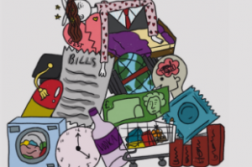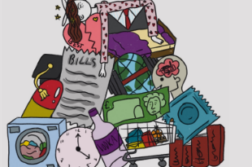It has become something of a strange trend in the fashion world to glamorise society’s poorest members in order to appeal to the wealthy – a trend which has been labelled ‘homeless chic’. Why has this appropriation even become a thing? Is it because a ‘run-down’ or ‘urban’ style is considered edgy? Has fashion lost touch with the reality of poverty as a social issue, and is it this lack of knowledge that allows poverty to be reborn as just another ‘reference’ for designers? Or is it simply that appropriating poor people’s ‘style’ of dress is another way to highlight their social status as something lesser? Whatever the case might be, it has a long history.
Though he was not the first designer to appropriate poverty as a stimulus for their designs, John Galliano’s spring 2000 couture collection for Christian Dior is the commonly-given point of origin for the ‘homeless chic’ trend. The designer explained that he had drawn inspiration from street people that he had noticed along the banks of the Seine after taking up jogging, and he incorporated these findings into his seventh couture collection for Dior. The collection was crafted from a specially-designed newspaper-printed silk, as well as other luxury fabrics that were ripped and aged so that they would appear dirty.
Columnist for the New York Times Maureen Dowd once quoted Galliano as saying, “It’s the most spoken-about topic at dinner parties in Paris.” He did not mean homelessness, but instead the positive reception of his couture collection. “One can’t go into a restaurant without hearing fantastic young ladies talking about the fraying of tulle of the Christian Dior show.” This suggests that Galliano cared less about bringing awareness to the subject matter that he had in a way leeched off of to create his 2000 couture collection, and instead was much more excited by the less important reception that it had received. Thus, in a way, those suffering in poverty were, and still are, being used as a commodity for the fashion world to receive praise and make money from those who are blinded by such terrible social issues.
It’s terrible to say, very often the most exciting outfits are from the poorest people – Christian Lacroix, toVogue.
In 2005 and 2006, fashion designers and child actresses’ Mary-Kate and Ashley Olsen’s’ love of wearing extremely oversized clothing in shoddily-assembled layers led many tabloids and fashion magazines to wonder if they too were adopting a kind of ‘homeless chic’ style, or just trying to escape the cutesy public image that they had developed from their childhood careers in the spotlight. In either case, they were probably the only people to earn comparisons to bag ladies whilst toting Chanel and Botkier, showing the explicit appropriation and ignorance involving in having a ‘homeless chic’ style among those with substantial wealth.
Television personality and model Tyra Banks pulled a number of stunts on her since-cancelled talk show, but perhaps the most questionable decision came in 2006 when she dressed up for a day as a homeless woman. Tyra said “I did a lot of research on the homeless epidemic in this country, and I came across these crazy, terrifying facts.” Following this, the then ‘homeless’ Tyra and her camera crew learned about how drugs were sold and smoked from two homeless teenagers. This is a clear example of the exploitation of homeless people. Tyra returned to the theme in 2008, when for Cycle 10 of her modelling reality show America’s Next Top Model, she had the contestants pose with real homeless women for a poverty-themed fashion shoot. It is not only the fashion industry, but also the media, that has drawn upon poverty and homelessness for money, and even entertainment.
In January 2010, Vivienne Westwood unveiled a ‘homeless chic’ collection in Milan. The show saw models using props that a stereotypical homeless person might own, including shopping trolleys and bedrolls. Another model emerged from a cardboard box with a sleeping bag, showing the questionable lengths that the show took the theme to, especially considering that it was likely more celebrated for its fashion than for bringing awareness to an important subject matter. The collection was another example of a fashion house being triumphant in using the hardships of poverty to create something ‘beautiful’ and celebrated. “Homeless chic?” said one magazine editor. “It is a little close to the bone. The clothes were fantastic, though.”
In September 2018, luxury London department store Selfridges and designer brand Balenciaga were forced to apologise following a backlash over a window display for clothes that critics branded “homeless chic.” They were accused of “trivialising” rough sleeping with the window display which included hooded mannequins in slumped positions. The display was deemed “insensitive”, with many feeling it used “homeless chic” and imagery of the poorest in society to target the richest, something that seems to be a trend across most of these cases.
Most recently, the row over glamorising poverty was reignited when in early 2020 French designer Maison Margiela released black Fusion leather mesh sneakers that were described as having a ‘deconstructed aesthetic’. The shoes were covered in drips of ‘glue’, something that social media users blasted as glamorising poverty. The interestingly designed shoes had the hefty price of £1,125 attached to them. It thus seems that this trend is one that is failing to die out, but hopefully the fashion world will soon learn that it is not ok to glamorise real life suffering.



